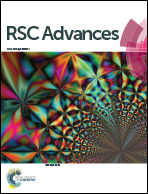Electrochemical performances of cobalt oxide–carbon nanotubes electrodes via different methods as negative material for alkaline rechargeable batteries†
Abstract
Co3O4/CNTs samples are synthesized via different methods and investigated as negative materials for alkaline rechargeable batteries for the first time. The reasons for performance difference of those Co3O4/CNTs electrodes and the impact of CNTs additive amount on cycling properties are explored in detail. CNTs can remarkably enhance the electrochemical activity of Co3O4 materials, leading to a notable improvement of discharge capacity, cycle stability and rate capability. Co3O4/CNTs-C composites via the one-pot reflux method exhibit the desirable electrochemical capability. Co3O4/CNTs-C8 sample (mass ratio of CNTs is 8%) shows the highest discharge capacity of 526.1 mA h g−1. Meanwhile, Co3O4/CNTs-C11 electrode (mass ratio of CNTs is 11%) displays the most outstanding cycle performance with a capacity retention rate of over 97.3% after 200 cycles. A properly electrochemical reaction mechanism of Co3O4/CNTs electrode is also constructed in detail.


 Please wait while we load your content...
Please wait while we load your content...